- Home
- Encyclopedia
- Oil To Market: A History of Pipelines In Wyoming
Oil to Market: A History of Pipelines in Wyoming
In economic terms, an oil well without a pipeline is like a heart with no arteries.
When, in its first decade, Wyoming’s oil production was limited to a few seeping fractures and shallow wells, conveying petroleum to market could be accomplished by use of simple whiskey barrels and horse-drawn wagons.
But as the number of prolific wells increased in the 1890s at places like the Shannon and Salt Creek fields north of Casper, Wyo., production outstripped the capacity of operators to move it effectively.
“Lack of transportation hitherto has kept the Salt Creek oil out of the market,” the Casper Press noted on April 21, 1911. “The wells have been drilled and then either plugged, or the oil has been wasted.”
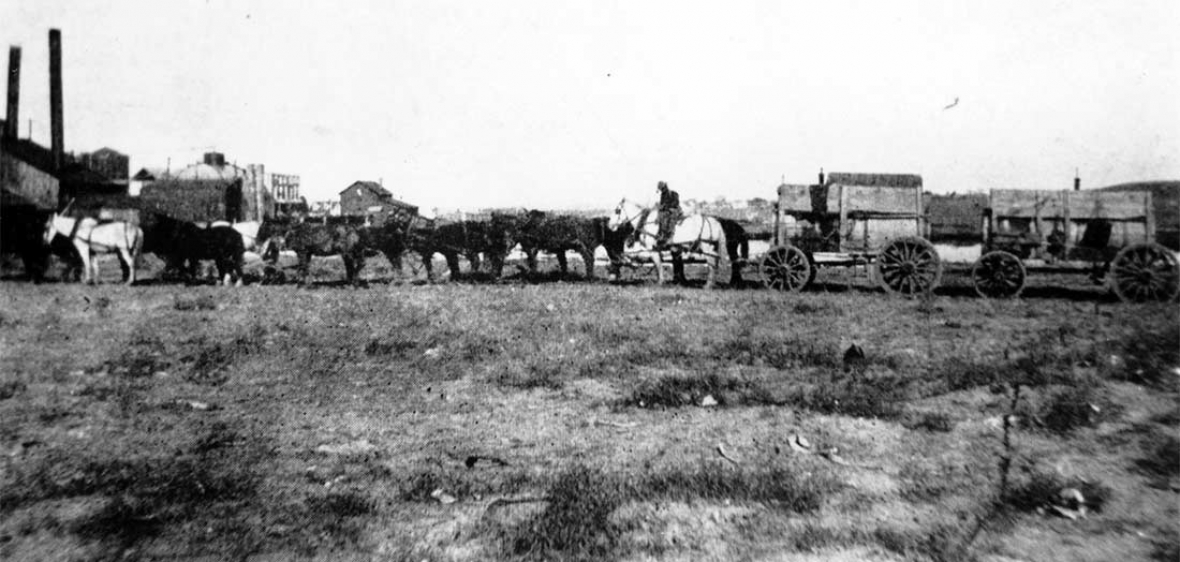
Early transport
Difficulties of oil transportation arose as soon as Edwin Drake became first in the United States to successfully employ a drilling rig to produce oil near Titusville, Pa., in 1859. Leaky barrels and even washtubs were used to haul away then modest amounts of crude oil.
But as oil exploration increased, more efficient means were required. One early plan called for a 6-inch diameter wooden pipeline to transport oil from an old salt well in Wirt County, W.Va., to a proposed refinery in Parkersburg. Due to the Civil War, the line was never built.
With drilling spreading across the continent, effective transport of crude oil became even more urgent. Wooden pipelines were eventually employed on a limited basis, along with cast-iron and wrought-iron lines in and around wells, as production ramped up.
Wyoming oilmen faced even greater transportation difficulties than their counterparts in the East, since oil fields were often developed at remote locations where terrain was difficult even in good weather.
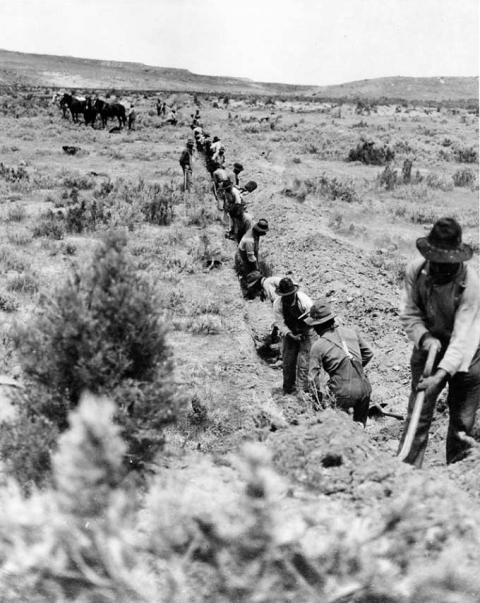
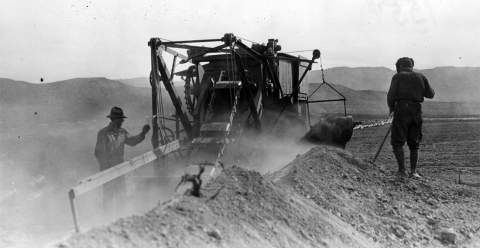
In the early days of the Shannon and Salt Creek fields, oil was hauled in strings of wagons pulled by so-called string teams of 12 to 18 horses or mules. The 100-mile round trip could take a week in good weather, or two weeks in bad. Teamsters carried shovel and picks, and sometimes were obliged to create a road as they went.
Freight wagons were used to haul all manner of materials from livestock feed and food rations to oilfield equipment and barrels filled with oil. A load of Shannon crude typically consisted of 45 barrels roped down in two or three wagons coupled together.
Prior to 1900, markets for crude oil were limited. The Union Pacific used some unrefined petroleum for lubricating railcar axles, and kerosene was used for lighting in rural homes. However, as the U.S. shifted from an agricultural to an industrial economy--coupled with introduction of the internal combustion engine and automobiles--the demand for oil accelerated.
Tank wagons and pipeline proposals
In 1895, Wyoming’s first oil refinery was constructed in Casper. “The Pennsylvania Oil and Gas company owns both the wells, of which there are now seven, and the refinery here,” the Natrona Tribune reported on Sept. 5, 1895. “Geo. B. McCalmont, who is the mayor of Casper as well as associate law judge of the district court and a good fellow to boot, is vice-president and manager of the company. He thinks his company will lay a pipe line from the wells to town probably next year.”
Despite such pipeline speculation, horse power remained the mainstay for hauling crude oil. New horse-drawn tank wagons left Casper in January 1898 for Salt Creek. It was 10 days before the outfit returned.
John McClure arrived in Casper on a Monday, with his 14-horse team and full tanks. The combined weight of his three wagons was 28,400 pounds, including 19,700 pounds of oil. This was 5,000 pounds more oil than was ever brought in by using barrels.
“Not only is there a great advantage with the new tanks in hauling more oil, but there is much time saved in loading at the wells and unloading at the refinery, and it is very likely that this method of transportation of the crude oil from the wells to the refinery be will continued until the demand for the product will warrant the oil company to put in a pipe line,” the Natrona County Tribune surmised.
And indeed, between 1889 and 1910, several pipelines and other oil transportation projects were considered in the state to handle the rapidly increasing production.
“Oil has been pouring out of the gushing Lander wells for some time,” oil expert James F. Callbreath observed in 1907. “We have been obliged to burn it to protect surrounding water and lands, as we have no way to store or ship it.”
A pipeline from Fremont and Converse counties to a railroad at Orin Junction was considered. Another plan envisioned a 6-inch pipeline with a capacity of 10,000 barrels of oil per day running from Casper to Laramie, then to Fort Collins and Denver.
In 1906, an Omaha syndicate proposed a pipeline between Lander and Omaha—which would have been the longest in the world—at a cost of $2 million. At the time, there were 13 flowing wells in the Popo Agie fields near Lander, and “twice every month, 1,000 barrels of oil have to be burned to keep the oil from flowing into the river and ruining the crops of the farmers along the stream,” according to the Wyoming Tribune.
A line from Salt Creek to Casper
In 1911, the Midwest Oil Co. completed a 6-inch diameter pipeline from the Salt Creek Field to a 2,000-barrels-per-day refinery in Casper.
“The demand for any kind of oil in the northwest is very great and the supply very small. The demand for gasoline is great everywhere,” explained the Casper Press article heralding the project. “At the extreme north end of the Salt Creek fields are the wells producing the Shannon lubricating oils, which have the first prize as lubricants at several world expositions, and which are hauled out in wagons.”
By November 1911, two pipelines had been completed from Salt Creek to Casper. During the same period, the Franco-Wyoming Co. ran a pipeline between Casper and Medicine Bow, Wyo., bringing oil to the Union Pacific Railroad. Another line was considered from Casper to Denver via Cheyenne. In addition to the Union Pacific, the intention was to supply the Burlington; Colorado and Southern; the North Western; the Great Western and the Northern Pacific railroads with oil for fuel.
Some new pipelines were dedicated to conveying natural gas. In 1911, home use of natural gas began in Greybull, Wyo. and Basin, Wyo. In 1912, gas was transported via pipeline from the nearby Byron field to the town of Byron, Wyo.
1920s boom
A major project to expand natural gas supplies in the Bighorn Basin was completed by the Big Horn Gas Co. in 1927. This entailed laying a pipeline from the Little Buffalo Basin Field in Park and Hot Springs counties to the Nowood River, where it tied into a gas main running to Greybull and other points north. The effort involved laying over 42 miles of 14-inch pipe and nearly 14 miles of 12-inch pipe.
A pipeline in the Lance Creek Field near Lusk, Wyo., was started in 1919 during an oil and gas boom. “Men working around the clock hired women to wait in line at the post office for their mail,” according to one account.
In 1921, Producers and Refiners Corp. and the Midwest Refining Co. built a 90-mile pipeline, the largest natural gas line in Wyoming at time. The state’s natural gas consumption had reached 15 billion cubic feet in 1921, driven largely by industrial-refinery and domestic users in Casper.
By 1928, a total of one gasoline, 20 natural gas and 39 oil pipelines–-nearly 2,000 miles of pipe in all—had been laid in Wyoming. Eight oil pipelines ran from the Salt Creek Field to Casper, the most of anywhere in the state.
Natural gas service was extended to many Wyoming towns in the 1930s, including Laramie, where the city’s first gas pipeline opened in 1933.
Oil and gas prices fell, however, after the stock market crash of 1929. One report indicated that soon after the bust, Salt Creek crude oil could be purchased for 19 cents a barrel. Prices stayed low, as the Great Depression dampened oil and gas activity through most of the 1930s.
Longer distances, more security
The end of the 1930s saw pipelines being built over longer distances—and requiring more security to protect them. In 1938, the first oil pipeline to cross from Wyoming into another state was laid from Lance Creek to Denver.
Some pipelines invited thievery, since gasoline could be siphoned off and sold on the black market.
Tom Heaney, a special deputy sheriff working on contract with the Stanolind Oil and Gas Co. in the late 1920s and early 1930s, patrolled a pipeline carrying naptha fuel from a refinery in Casper back to Salt Creek to run the pumps on the oil wells. This particular line was constructed of 4-inch, welded steel pipe, buried about 30 inches deep. Heaney and his men were armed, and very often, so were their adversaries.
As World War II loomed, officials in the U.S. government grew increasingly concerned about oil transportation security.
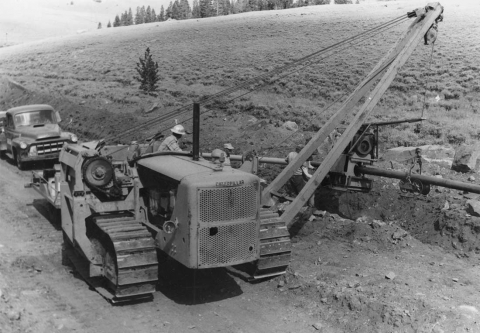
After America entered the war, Secretary of the Interior Harold Ickes supported pipeline construction in order to move crude oil overland from Texas to the East Coast, thus avoiding attacks by German U-boats on the high seas. The result was two pipelines --the 24-inch diameter “Big Inch” and the 20-inch diameter “Little Big Inch.” The lines were built by the War Emergency Pipelines Company, a nonprofit corporation backed by the largest U.S. oil companies. Both were completed in 1943.
At the same time, advances in metals, welding techniques and pipe manufacturing during the war made major pipelines economically attractive.
New, more distant markets
In 1952, the Platte Pipeline was constructed. This landmark project opened wholly new markets in the Midwest for oil produced in the Rocky Mountain region. When completed, the pipeline linked Wyoming oil fields via Casper to points as far east as Wood River, Ill., a distance of 1,056 miles. It was originally called the “Downhill Pipeline” since the journey to Illinois was all downhill.
The Platte Pipeline was built by the five owners of the Platte Pipe Line Co. – Gulf; Conoco; Marathon; Pure Oil, a division of Union Oil of California; and Sinclair Pipeline. Total cost (in 1952 dollars) was $69.35 million.
The Belle Fourche Pipeline was constructed in the mid-1950s to carry oil from fields in northeastern Wyoming, where the river of the same name is located.
“After trying without success to get every pipeline even remotely associated with northeastern Wyoming to build a pipeline, we decided we would have to do so ourselves,” True Oil Co. founder H.A. “Dave” True said in an Aug. 23, 1991 speech before the Newcomen Society of the United States. “So the five working-interest owners, including True Oil Co., in our group of Donkey Creek leases formed the Belle Fourche Pipeline Co. …”
By 1967, Casper-based True Oil Co. had bought out the remaining outside interest in the Belle Fourche Pipeline Co.
During the 1980s oil-price bust, petroleum production declined, and many of the Platte Pipeline’s operating facilities were essentially mothballed. In the mid-1990s, oil sands petroleum from Alberta entered the market, and along with it, increased demand from Midwestern refineries for use of the Platte Pipeline.
Alberta Energy and TransCanada bought the Platte Pipeline and also built the Express Pipeline between Hardisty, Alberta, and Casper. In the process, the Platte Pipeline was upgraded.
Recent booms
Booms in natural gas activity ushered in a new chapter in Wyoming’s pipeline history in the 1990s. New projects, especially related to coal-bed methane in the Powder River Basin and tight-sands natural gas production in Jonah Field and on the Pinedale Anticline, resulted in the construction of long-distance lines to both the West Coast and Midwest.
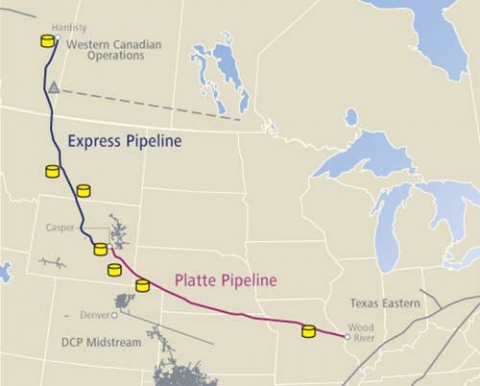
Because export pipeline capabilities were severely limited, Wyoming natural gas producers were receiving only a fraction of the national average price. So building new natural gas pipelines became a high priority.
In 1985, Kern River Gas Transmission Co. submitted an application with the Federal Energy Regulatory Commission to build a high-pressure natural gas pipeline from southwestern Wyoming to southern California. It went into service on Feb. 15, 1992.
In 1997, the Express Pipeline out of Canada began operations, and now connects with the Platte Pipeline. The Express line transports crude from Alberta to markets in the U.S., including a new crude-oil-to-railroad loading facility in Casper. Oil in the Platte Pipeline comes mostly from domestic sources like the booming fields of the Bakken shale of western North Dakota.
The 21st Century
In 2003, a major expansion increased Kern River’s capacity on the Wyoming-to-California line. Additional expansion projects boosted the capacity even more, bringing the 2014 design capacity to 2.17 billion cubic feet per day.
In 2010, construction began on a major project between the pipeline hub at Opal, in western Wyoming, and Malin, Ore. The 680-mile-long Ruby Pipeline provides natural gas from Rocky Mountain production zones to customers in California, Nevada and the Pacific Northwest.
The 1,698-mile-long Rockies Express pipeline system was the largest natural gas pipeline built in decades and one of the largest such lines ever built in North America. It became fully operational in November 2009 with a design capacity of 1.8 billion cubic feet of natural gas per day.
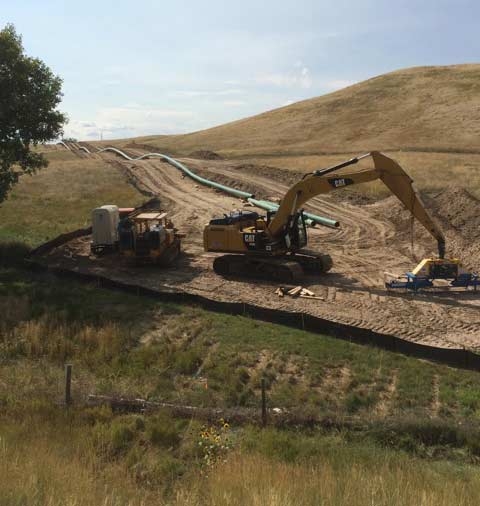
Rockies Express was intended to move a glut of natural gas from Wyoming and Colorado to markets as far away as the East Coast, and thus address low natural gas prices by providing an option in high-demand markets. And for a time, western prices began to rise.
“What was unforeseen was the finding of natural gas in the Marcellus and Utica shale,” Matt Sheehy, president of the Rockies Express Pipeline, said in a 2014 interview with North American Oil & Gas Pipelines. These massive reserves are located primarily in Pennsylvania, New York and Ohio.
As a result of developments in the Marcellus and Utica shale, the importance of the Rockies Express as a long-haul option was diminished. But because it was a relatively new line, Tallgrass Energy and other owners also saw an opportunity. They sought to ship gas in two directions, thus making it possible to provide more natural gas to big Midwestern markets.
With the pipeline shipping both west to east and east to west, natural gas customers would be afforded a choice of supplies from either the Rockies or from the Marcellus and Utica dry shale developments as well as from traditional Gulf Coast sources.
In 2013, Tallgrass Energy won the right from the FERC to ship natural gas from east to west in the Midwest without violating agreements with western shippers.
Between 1999 and 2008, at least seven large-capacity header-laterals, which transported natural gas from local gathering systems to interconnections with major interstate pipelines, were built in Wyoming.
Changing fortunes in the oil and natural gas business have sometimes meant switching a pipeline’s purpose.
The Pony Express Pipeline, which now runs from Guernsey in eastern Wyoming to Cushing, Okla., was converted from crude oil to natural gas in 1996. But in 2014, its use changed again when a Tallgrass Energy offshoot, Tallgrass Development LP, decided to transport oil in the pipeline at a time natural gas prices were low while petroleum prices remained strong. The line transports crude oil from Wyoming, North Dakota and Montana. Tallgrass Energy acquired the Pony Express Pipeline from Kinder Morgan in 2012.
By 2014, there were at least 9,235 miles of crude-oil and 24,726 miles of natural-gas pipelines in Wyoming, including both gathering and transmission lines. The Wyoming Pipeline Authority also reported at least 1,896 miles of pipeline used to move refined commodities such as diesel and gasoline, as well as 1,758 miles for natural gas liquids.
In addition to pipelines, railroads became increasingly important as a means of transporting oil and natural gas. A Casper Star-Tribune analysis found that total Union Pacific and Burlington Northern Santa Fe rail shipments of crude oil, gasoline and natural gas increased to about 16,400 cars in 2013, up from approximately 10,200 in 2012. Shipments originating in the state were up 70 percent, while shipments from outside the state increased 56 percent.
Editor's Note: We extend special thanks to the University of Wyoming’s School of Energy Resources for support for this and other articles in an ongoing series on the history of Wyoming’s energy and extraction businesses.
Resources
Primary sources
- Bill Barlow’s Budget. “A Huge Concern,” Jan. 4, 1888, 1.
- Casper Tribune Herald. “Pipeline Construction for Coming Year is Assured,” Feb. 19, 1928, section 2, 21.
- Casper Press. “Pipe-line is Now Assured,” April 21, 1911, 1. Accessed Dec. 16, 2014 via http://newspapers.wyo.gov/.
- Casper Star-Tribune. “Shotgun Patrol of the Gas Pipeline,” March 21, 1965, 8-10.
- Kramer, Bradley. “Rockies Express Pipeline Gets a Second Chance,” North American Oil & Gas Pipelines, Feb. 25, 2014. Accessed Nov. 9, 2014 at http://napipelines.com/resurexion/.
- Storrow, Benjamin. “Numbers skyrocket for rail shipment of oil in Wyoming,” Casper Star-Tribune, June 29, 2014. Accessed Dec. 6, 2014 at http://trib.com/business/energy/numbers-skyrocket-for-rail-shipments-of-oil-in-wyoming/article_d2b49099-c3ec-54c3-9083-7eb789b9e4a9.html.
- Wheatley, Richard N., director of corporate communications/public affairs, Kinder Morgan, Inc. Emails communications with author, Nov. 4-10, 2014.
- Wind River Mountaineer. “Asks for Pipeline from Lander,” June 21, 1907, 1.
- Wyoming Tribune. “Huge Project,” Jan. 8, 1906, 5.
Secondary sources
- Anderson, Susan. “The Big Switch: Pipeline Turns from Natural gas to Oil in Wyoming,” Casper Star-Tribune, Feb. 7, 2014. Accessed Nov 12, 2014, at http://trib.com/business/energy/the-big-switch-pipeline-turns-from-natural-gas-to-oil/article_f426d394-14e6-5440-affb-42858947750a.html.
- Kern River Transmission Co. Background and history information. Accessed Nov. 11, 2014, at http://www.kernrivergas.com/InternetPortal/BackDesktop.aspx?TabID=36&TabParentID=22.
- Pees, Samuel, T. “Early Oil Pipelines, U.S.A,” Oil History. Accessed Nov. 7, 2014, at http://www.petroleumhistory.org/OilHistory/pages/Pipelines/pipelines.html.
- Roberts, Phil. “A History of Oil in Wyoming.” In A New History of Wyoming. Accessed Nov. 8, 2014, at http://www.uwyo.edu/robertshistory/history_of_oil_in_wyoming.htm.
- __________. “The Oil Business in Wyoming.” Accessed Nov. 10, 2014, at /encyclopedia/oil-business-wyoming.
- Sprowl, Craig, coordinator of communications services, Spectra Energy. “Texas Eastern: Still Looking Good at 65.” Accessed Nov. 24, 2014, at http://www.spectraenergy.com/About-Us/History/Texas-Eastern/
- Tallgrass Energy. “Rockies Express Pipeline (REX).” Accessed Nov. 12, 2014, at http://www.tallgrassenergy.com/Pipelines/REX/.
- U.S. Energy Information Service, Office of Oil and Gas. “Natural Gas Pipelines in the Central Region,” based on data through 2007/2008, with selected updates. Accessed Nov. 12, 2014, at http://www.eia.gov/pub/oil_gas/natural_gas/analysis_publications/ngpipeline/central.html.
- Winter, Maxwell W. “Natural Gas Industry had Start in Basin Region,” Casper Tribune Herald, Feb. 19, 1928, section 2, page 6.
- Wyoming Pipeline Authority. “Crude Oil Pipelines in the Rockies: An Historical Review,” June 2010. Accessed Dec. 8, 2014, at http://www.uwyo.edu/eori/_files/co2conference10/crude%20oil%20pipelines%20publish_secure.pdf.
For further research
Natural gas pipeline construction video from Spectra Energy and the Interstate Natural Gas Association of America, http://www.youtube.com/watch?v=_gW6EU0g6ys.
Illustrations
- At the Casper College Western History Center, the photo of the string team is from the Kukura-True Collection, the photo of the trencher is from the BP-Amoco Collection and the photo of the tractor and side boom are from the Kinder-Morgan Collection. Used with permission and thanks.
- The photo of men digging a trench by hand is from the Industry and Oil Collection at the Wyoming State Archives. Used with permission and thanks.
- The map of the Express and Platte pipeline routes is from Spectra Energy. Used with permission and thanks.
- The photo of pipe ready to go in the ground west of Douglas is by Tom Rea.

